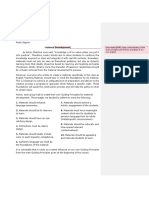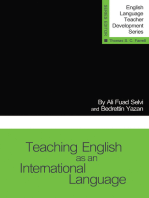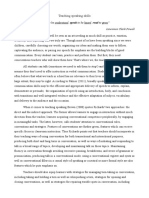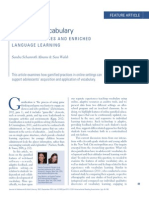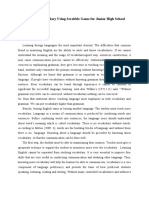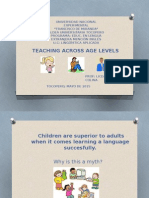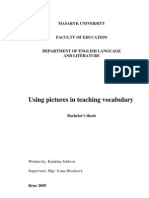Using Games To Develop Speaking Skills PDF
Using Games To Develop Speaking Skills PDF
Uploaded by
Paulina EscobarCopyright:
Available Formats
Using Games To Develop Speaking Skills PDF
Using Games To Develop Speaking Skills PDF
Uploaded by
Paulina EscobarOriginal Title
Copyright
Available Formats
Share this document
Did you find this document useful?
Is this content inappropriate?
Copyright:
Available Formats
Using Games To Develop Speaking Skills PDF
Using Games To Develop Speaking Skills PDF
Uploaded by
Paulina EscobarCopyright:
Available Formats
ISSN 1798-4769
Journal of Language Teaching and Research, Vol. 3, No. 4, pp. 801-805, July 2012
2012 ACADEMY PUBLISHER Manufactured in Finland.
doi:10.4304/jltr.3.4.801-805
Using Games to Improve Students'
Communicative Ability
Deguang Zhu
North China Institute of Science and Technology, Yanjiao, Beijing-east, China
Email: zhudeman@sina.com
AbstractIt is believed that the communicative language teaching approach (abbreviated as CLTA) is one of
the most effective methods to keep away from the weaknesses of the traditional English teaching method in
developing students communicative ability. Using games, which is communicative in essence, are often
considered effective in developing students communicative ability. In order to help English teachers put the
communicative language teaching approach into practice, this paper, on the basis of pointing out the
weaknesses of the traditional English teaching method, discusses what the communicative language teaching
approach is, states the value and importance of using games in English-teaching class, introduces eight types of
games that could be used in class, and presents some suggestions when using the games.
Index Termscommunicative ability, games, suggestions
I. INTRODUCTION
Many have been said about the weaknesses of the traditional English teaching method in China, and the strengths of
the communicative language teaching approach. However, the general situation of Chinas English teaching and
learning at present is not very satisfactory, as dumb English is still stubbornly rooted in a large number of English
learners. So it is safe to say that there is still a long way to go in English teaching reform and improving the English
teaching quality of China. Sometimes it is easy to get a new method like the communicative language teaching
approach heard but difficult to get it accepted, understood and applied to practical classroom teaching in the end.
Therefore, it is not out of date to discuss the techniques of applying the communicative language teaching approach to
classroom teaching. In this paper, the author, on the basis of pointing out the disadvantages of the traditional teaching
method, discusses and explores one way to teach students effectively using games in the English class, which is often
considered as one of the best way to get the students involved in the classroom activities in which their communicative
ability is practised and improved. Language games, as one of the most valuable and effective techniques in English
language teaching, have been used for a long time by many western teachers. However, they are less used in China,
especially in College English Teaching classrooms. Most teachers and students think games are a waste of time or just a
fun activity for children. In this article, the author proposes to talk about the importance of using games in College
English Teaching and list eight types of games to practise students' speaking and listening. Finally, some considerations
are put forward on using games and the success of using games is stated.
II. TRADITIONAL TEACHING METHOD
For years, the main method of teaching English in China is like this: firstly, the teacher explains the new words in the
vocabulary list by giving definitions and examples. Then he/she will give a brief introduction to the background of the
text. When dealing with the text, the teacher always explains and translates it sentence by sentence or even word by
word, sometimes with a few questions which seldom elicit answers or responses from students. Finally, a reciting task
or translation exercise is given to the students. In short, the traditional way of English teaching is teacher-centered and
language-knowledge-focused. The way of teaching English is similar to that of teaching mathematics: new words
presented, related grammar explained, and then written exercises assigned; if students can do the exercises well, it
means that they have learned the language knowledge well, and then the lesson moves on. Under such pattern of
teaching, students are passive information receiver and written exercises doer. They can remember large numbers of
words and grammatical rules, and they can do very well in exams, but they scarcely have chances to express themselves
in the target language and test their understanding of the received information about the language. And they are found
having a lot of difficulty in communicating with others in English. This phenomenon is ironically defined as Dumb
English, which is the product of long hard work of both teachers and students.
III. COMMUNICATIVE LANGUAGE TEACHING APPROACH
As the foreign language pedagogy has developed over the past few decades, we have experienced a number of
methods and approaches to language teaching. Out of them the Communicative Language Teaching Approach
(abbreviated as CLTA), at length, characterizes the present era.
2012 ACADEMY PUBLISHER
802
JOURNAL OF LANGUAGE TEACHING AND RESEARCH
CLTA is best understood as an approach, not a method. It is based on the theory of the nature of language and of
language learning and teaching. Language in nature is communicative for different purposes. It is a system for the
expression of meaning. Its primary function is for interaction and communication. So the goal of language learning and
teaching is to develop communicative competence. This communicative competence, in Canale and Swains view
(1980), includes grammar competence, sociolinguistic competence, discourse competence, and strategic competence.
The acquisition of these competences, therefore, involves both cognitive and behavioral aspects, and the developments
of the four basic skills at the same time. As we can see, this reasonable theoretical basis, perhaps, is just the reason why
CLTA is attractive or popular.
CLTA emphasizes the importance of using authentic language. Language techniques are designed to engage learners
in the pragmatic, authentic, functional use of language for meaningful purposes. So such communicative activities as
authentic texts, scrambled sentences, language games, picture strip stories, role-play, should be used. Learners must be
provided with ample opportunities to use the language themselves for communicative purposes. They are encouraged to
deal with unrehearsed situations under the guidance of the teacher. The teachers main tasks are to facilitate the
communication process between the learners in the classroom and also to act as an independent learner within the
learning-teaching group. The teacher should be, therefore, an organizer, a guide, a researcher, a needs analyst, a
counselor, a group process manager, and a learner too, but not a controller. The instructional materials are text-based,
task-based and realia. Communicating to learn and learning to communicate is the best description of CLTA.
CLTA, as a teaching approach, takes in all the new achievements in pedagogy, psychology and linguistics, so it is
excellent in theory and beneficial to language learning and teaching. As for its operability, it is actually a matter of
different variables according to different persons in different situations. CLTA is usually regarded as a guiding thought,
which should be carried out in language learning and teaching activities. So how to put the guiding thought into practice
becomes an ever-lasting topic for English teachers and researchers to work on, and the study of this topic can never be
exhaustive.
IV. THE VALUE AND IMPORTANCE OF USING GAMES
There are many good ideas about English teaching. Among these, using games in the English class is the one which
is most easily accepted by students and which is also a very useful and helpful aspect of communicative method. As is
known to everyone, game is an activity providing entertainment or amusement; its a competitive activity or sport in
which players contend with each other according to a set of rules. A game is an activity carried out by co-operating or
competing decision-makers, seeking to achieve, within a set of rules, their objectives (Rixon 1981). A game is an
activity that both the teacher and students enjoy doing. It is student-centered and as appealing as playing in the
playground.
Using games in English class can get students relaxed and enjoying using the language. It may be argued that college
students, unlike children, having grown up, do not need games to relax themselves. On the contrary, adults sometimes
feel more nervous than children when they face new things, and they are more afraid of losing their face as the sense of
face develops with their age. In this sense, they do need games or any other activity that help them relaxed and innocent
like children to the new language without being afraid of making mistakes. According Stephen Krashen (1982), second
language acquisition is influenced by affective factors either positively or negatively. One of the teachers tasks is to
create a situation where students affective filter is lowered so that the comprehensible input could be taken in. The first
aim of using games in class is just to create such a situation.
Games are communicative in essence, and so using game in English teaching and learning can well realize the
fundamental idea of the communicative language teaching approach. Using games is a good way to improve students'
various skills, as Wright, Betteridge and Buckby (2006) say, "Games can be found to give practice in all the skills, in all
the stages of the teaching and learning and for many types of communication". In playing language games, students
have to know and well understand the rules of the games, and should be clear about what has been, is being and will be
done or said, and what is more important, they have to take some actions doing or saying something, to compete in the
games. In so doing, they can practise their skills of listening, speaking, reading and writing comprehensively, and
especially they get more practice in listening and speaking, which are poor in the traditional teaching method.
Littlewood (1981) proposed that through games, teachers should help learners go beyond the mastery of structures, to
the point where they can use them to communicate meaning in real situations.
Game playing is effective in developing students communicative ability in that it is a dynamic process of
communication in which students as thinking beings, emotional beings and communicators instead of knowledge
receptacles, try to get their ideas, concepts, thoughts, emotions and feelings expressed, based on their own life
experiences. Psychologist Piaget (2001) proposes that movement produces thought. He believes that movement is the
beginning of learning, and that cognitive frame is built up step by step whose joint is the movement but not the
consciousness.
In addition, games may help and encourage many learners to support their interest and work (Wright 2006). Games
can increase motivation to learn the language as students, especially the weaker ones, feel a real sense of achievement
when they manipulate a game (Hubbard 1987). Games can provide quite extensive knowledge input. Games can
increase students' communication and co-operation with each other. And games can act as a testing mechanism through
2012 ACADEMY PUBLISHER
JOURNAL OF LANGUAGE TEACHING AND RESEARCH
803
which they will expose areas of weakness and the need for remedial work.
Furthermore, games can be used at any stage in a lesson: at the beginning to diagnose what the students can or cannot
do; during the lesson for language practice purposes; or at the end as reinforcement and reward. Students playing
language games are encouraged to express their ideas for certain purpose, and they can use different types of games at
different stages appropriate for different types of language learning.
V. TYPES OF GAMES
As stated above, the main purpose of using games in English classes is to practise students' different skills, especially
their communicative ability. Here, eight types of games from published sources (Carrier 1980, Ellis 1986, Harmer 1985,
Kallsen 1982, Klippel 1984, MaCallum 1980, Porter-Ladousse 1987, Stern 2002, Willis 1982, etc.) are identified,
discussed and explored.
A.
Guessing Games
The basic role of guessing games is very simple: one person knows something that another one wants to find out. The
thing to be guessed can differ greatly from game to game. It can be a word, an object, an activity or many other things.
Guessing games are useful in helping students practise logical thinking and asking questions. 3-item story is one
example of a guessing game. One person in a group knows the story in which there are three items given to the other
members of the group. Depending on the three items, they have to ask questions to find the story. The person who holds
the story can only give yes or no answers. The guessing members have to use their questioning skills to get the answer.
To give an example of pun: the teacher gives the students a question to explain: Why do they tie a horse to a post
before a race? The students have to widen their thinking instead of being occupied in a narrow way and be told to think
of more than one sense of a word or a sentence. Then after a period of thinking, they are likely to find the answer:
Because they want to make the horse fast. Here, fast has two meaning which can be firmly fixed or quick.
B.
Picture Games
Picture games include several types:
Comparing and contrasting pictures;
Considering differences or similarities;
Considering possible relationships between pictures, such as narrative sequence;
Describing key features so that someone else may identify them or represent them in a similar way;
Making a story according to the given picture.
Most of these picture games involve the learners in the relatively free use of all the language at their command and at
the same time give them the opportunity to practise their speaking and listening.
C.
Sound Games
Sound effects can create in the listeners mind an impression of people, places and actions. There is a demand for the
listener to contribute through the imagination. This inevitably leads to individual interpretations which mean that the
listeners can exchange their points of view and express opinions and ideas. This kind of games can stimulate students'
imagination and thinking, and offer them a chance to practise their listening and speaking. Students can make guess at
the object described by sound, or make dialogue or a story.
D.
Mime
Mimes can be done in pairs, groups or even by the whole class. One side has to perform the mimes for the other side
so that the answer can be found. It can be an object, action or person. So miming activities are valuable
language-learning situations. Guessing something is linked with the real desire to find out and thus is a true
communication situation. Miming trains the students' skill of observation and improvisation. It emphasizes the
importance of gesture and facial expression in communication. For example:
A guest in a hotel in an English-speaking country has a very bad cold and has lost his voice. He wants the receptionist
to help him turn on the heating. But he has to mime because of his voice. He tries to make the receptionist understand
him by using gestures and expressions. The receptionist makes guesses by asking questions in order to find out what he
wants. The activity will not stop until the receptionist gets exactly what the guest wants to do. This game can be done in
pairs or in groups.
E.
Fact-finding Games
This mainly deals with general knowledge and is a very practical exercise. Everyday, there is something important
happening, so the students can be asked what happened on a day in history. It may be a historical accident, a birthday of
a famous person, or something strange or marvelous. Then further details can be asked. The students can discuss in
pairs or groups in order to find much more information.
If the students have a class on 16 April, the teacher can ask the students to do the following activity. Let the students
sit in groups. Ask the question, Do you know who the main actor in the films Modern Times, The Gold Rush and
The Great Dictator is? The students are sure to name Chaplin, because the films are very famous. Then the teacher
2012 ACADEMY PUBLISHER
804
JOURNAL OF LANGUAGE TEACHING AND RESEARCH
tells the students that that day is his birthday and that it is necessary for the students to know something about him.
After that, more work can be done by drawing a typical picture of him and describing his appearance. At last, the
teacher can ask the students to think why Chaplin is loved by people all over the world and why his films are so popular.
Now the students have had a chance to really think about what they know about the person.
F.
Debates
In this activity, a topic is given and two sides are set up, one supporting the idea and the other opposing it. Then they
argue giving their evidence. The aim of this activity is to get the students to talk and stimulate their interest and
competitive spirit. Such activities make the students think about their values and priorities. There is no doubt that this
activity will improve students conversation and eloquence.
G. Jigsaw Games
Each participant in a jigsaw task holds one part of a solution, which may be a story, a factual text or a picture. They
are equally important. They should work together to fit their pieces together to find the solution. They, therefore,
improve co-operation and mutual acceptance within the group. Participants in this game have to do a lot of talking
before they are able to fit the pieces together in the right way. Wright (2006) also claims that these games practise two
very different areas of skill in the foreign language: Firstly, the students have to understand the bits of information they
are given and describe them to the rest of the group. This helps them realize the importance of pronunciation and
intonation in making oneself understood. Secondly, the students have to organize the process of finding the solution
and a lot of interactional language is needed.
H.
Role Plays
Role plays often consist of short scenes, which can be realistic or pure fantasy. Role plays may be enacted around
everyday situations as well as around topical problems. One easily-obtained role play is from the text, which may be
actual role play material. After learning the text, students can be asked to give a performance of it. This can improve
their oral performance generally and, of course, help students to understand what they have learned in an easy way.
Furthermore, role plays are useful for generating free expression and the feeling of spontaneity in the language
classroom.
VI. SUGGESTIONS ON USING GAMES
There are four elements which should be taken into consideration when playing games in English class. Teachers
should keep them in mind and apply the above discussed games to the practical situation appropriately in order to
achieve the best results.
A. Time
The amount of teaching time devoted to games depends on the individual teaching content, but it will probably be a
relatively small proportion of the total teaching time. They can be used to open or close a lesson in a stimulation way, to
punctuate a lesson, to relieve tension after a test or concentrated practice session, or at any time that the teacher feels
appropriate. It is important that they are used positively, to give students enjoyment and useful practice.
B. Choice
In each category of game mentioned above, there are different kinds of games. So the teacher must take many factors
into account when deciding which game would be most appropriate and most successful with his or her students at any
time. He or she should consider the level of the students, the main aim of having a game, the interest of the students, the
appropriate time to use a game and the availability of aids and materials.
C.
Preparation
Games may be good fun but they need to be carefully prepared and organized. Firstly, the teacher should find a good
game in a book or invent one. Then he or she must be sure that the necessary facilities are available. An overhead
projector can be very useful if one is available. If not, a typewriter and cards and the objects needed should be prepared
in advance. Also, the teacher should ensure clear handwriting on paper or cards so that the students will take the
teacher's intentions seriously. Finally, the teacher must work out how the game is to proceed, what the students will
need to do and how they will be instructed in what to do. It is important to try to anticipate any logistic or linguistic
problems that may occur in order to be able to deal with them effectively.
D.
Management
The teacher must decide in advance how to organize the students and the classroom so that the setting up of a game
can be carried out as quickly and smoothly as possible. It is advisable to encourage pair and group work where possible,
as this will increase student participation and the amount of language practice offered to each student will be much
greater. While the students are working, it is useful for the teacher to keep a close eye on pairs or groups to help, correct
or stimulate less active students. The teacher should stop a game and change to something else before the students
2012 ACADEMY PUBLISHER
JOURNAL OF LANGUAGE TEACHING AND RESEARCH
805
become tired of it. In this way, their willingness and concentration are retained.
VII. CONCLUSION
From the above analysis, a conclusion can be drawn that teaching and learning English by means of language games
is effective and efficient in improving students communicative ability. While in the traditional method of teaching
English, students sit still listening to teachers talking about English language and try their best to remember English
words and grammatical rules by rote memory, in the communicative language teaching approach they are actively
involved in playing games which in turn can arouse and maintain their interest in learning, promote their motivation of
study, and at the same time get lots of opportunities to have their basic skills of listening and speaking practiced.
Admittedly, there are many difficulties in using games in most English classes, but it is possible to use them as long as
both teachers and students appreciate their value and function. When using games, such factors as the time, choice,
preparation and management should be put into consideration, which is the guarantee of successful use of language
games in class. In a word, using games in English teaching very well represents the theme of the communicative
language teaching approach Communicating to learn and learning to communicate.
REFERENCES
[1]
[2]
[3]
[4]
[5]
[6]
[7]
[8]
[9]
[10]
[11]
[12]
[13]
[14]
[15]
[16]
Canale, M., M. Swain. (1980). Theoretical bases of communicative approaches to second language teaching and testing.
Applied Linguistics,1, 1-47.
Carrier, Michael. (1980). Take 5 Games and Activities for the Language Learner. Edinburgh: Nelson 's Company.
Ellis, Rod. (1986). Understanding Second Language Acquisition. Oxford: Oxford University Press.
Harmer, J. (1985). The Practice of English Language Teaching. New York: Longman.
Hubbard, J. (1987). A Training Course for ELT. Oxford: Oxford University Press.
Kallsen, Loren J. (1987). Advanced Communication Games. Edinburgh: Nelson's Company.
Klippel, Fredric. (1984). Keep Talking. Cambridge: Cambridge University Press.
Krashen, S. (1982). Principles and Practice in Second Language Acquisition. Oxford: Pergamon.
Littlewood, William. (1981). Communicative Language Teaching. Cambridge: Cambridge University Press.
MaCallum, G. P. (1980). 101 Word Games. Oxford: Oxford University Press.
Piaget, Jean. (2001). The Language and Thought of the Children. London: Routledge.
Porter-Ladousse, G. (1987). Role Play. Oxford: Oxford University Press.
Rixon, Steven. (1981). How to Use Games in Language Teaching. London: Macmillan.
Stern, H.H. (2002). Fundamental Concepts of Language Teaching. Shanghai: Shanghai Foreign Language Education Press.
Wright, A., D. Betteridge, M. Buckby. (2006). Games for Language Learning (3rd edn.). Cambridge: Cambridge University
Press.
Willis, J. (1982). Teaching English Through English: A Course in Classroom Language and Techniques (Handbooks for
Language Teachers). London: Longman.
Deguang Zhu was born in Guyuan County, Hebei Province, China in 1967. He received his M.A. degree in foreign linguistics and
applied linguistics from Beijing University of Aeronautics and Astronautics, China in 2002.
He is currently an associate professor in the School of Foreign Languages, North China Institute of Science and Technology,
Yanjiao, Beijing East, China. His research interests include linguistics, second language acquisition and foreign language teaching
methodology.
2012 ACADEMY PUBLISHER
You might also like
- Unit 3.module 2Document6 pagesUnit 3.module 2ngtchung100% (2)
- Exercise: Voiceless Velar Central Oral Stop Noiced Alveolar Central Nasal StopDocument5 pagesExercise: Voiceless Velar Central Oral Stop Noiced Alveolar Central Nasal StopHoiConNguyenNo ratings yet
- A Short Course in Teaching Reading Skills by Beatrice Mikulecky (Summary)Document26 pagesA Short Course in Teaching Reading Skills by Beatrice Mikulecky (Summary)Miguel Lamas80% (5)
- Essay Material Development (3694)Document3 pagesEssay Material Development (3694)Paola Segnini100% (1)
- Narratives of Adult English Learners and Teachers: Practical ApplicationsFrom EverandNarratives of Adult English Learners and Teachers: Practical ApplicationsNo ratings yet
- Teacher Talk and Student Talk: Classroom Observation StudiesFrom EverandTeacher Talk and Student Talk: Classroom Observation StudiesNo ratings yet
- The Role of Fun and GamesDocument14 pagesThe Role of Fun and GamesDanielaNo ratings yet
- Six Proposals For Classroom TeachingDocument2 pagesSix Proposals For Classroom TeachingFebriRotamaSilabanNo ratings yet
- Communicative Approach To Language TeachingDocument2 pagesCommunicative Approach To Language TeachingVera A. GuljašNo ratings yet
- Exposure and Focus On FormDocument3 pagesExposure and Focus On FormPaulina-No ratings yet
- Functions of GamesDocument9 pagesFunctions of GamesangelNo ratings yet
- 11.how To Teach Speaking Skill: Related PapersDocument7 pages11.how To Teach Speaking Skill: Related PapersLilis KarmilaNo ratings yet
- Reflective Essay Final of The FinalDocument3 pagesReflective Essay Final of The Finalapi-285632855No ratings yet
- Teaching Listening Micro-Skills For Listening ComprehensionDocument117 pagesTeaching Listening Micro-Skills For Listening Comprehensionnielsen1990No ratings yet
- Roles of Songs and Poetry in Esl ClassroomDocument9 pagesRoles of Songs and Poetry in Esl Classroom芳凯No ratings yet
- Using Authentic Materials in The ClassroomDocument18 pagesUsing Authentic Materials in The Classroomannmarietunney100% (2)
- Accuracy and FluencyDocument4 pagesAccuracy and FluencyZurain YusofNo ratings yet
- 8 Test Techniques and Testing Overall...Document9 pages8 Test Techniques and Testing Overall...Eric TiptonNo ratings yet
- Teaching Speaking SkillsDocument6 pagesTeaching Speaking SkillsPoppyannaNo ratings yet
- Gamified Vocabulary: Online Resources and Enriched Language LearningDocument10 pagesGamified Vocabulary: Online Resources and Enriched Language LearningdjelifNo ratings yet
- 2015 - How Does Technology Affect Language Learning Process at An Early AgeDocument6 pages2015 - How Does Technology Affect Language Learning Process at An Early AgeridwanaNo ratings yet
- EflDocument92 pagesEflAnonymous 9G5HfFNo ratings yet
- TESOL Quarterly (June 2007)Document210 pagesTESOL Quarterly (June 2007)dghufferNo ratings yet
- MAT (Tham Khao)Document5 pagesMAT (Tham Khao)Huỳnh Lê Quang ĐệNo ratings yet
- EFL in The Classroom-II (5662) : Diploma TeflDocument20 pagesEFL in The Classroom-II (5662) : Diploma Tefltouheeda zafar100% (1)
- Summarize: Common Method of Teaching English For Specific PurposeDocument12 pagesSummarize: Common Method of Teaching English For Specific Purposeanna marthinneNo ratings yet
- Teaching Vocabulary Using Scrabble Game For Junior High SchoolDocument8 pagesTeaching Vocabulary Using Scrabble Game For Junior High SchoolTaruli ElbinaNo ratings yet
- The Importance of Technology On Language LearningDocument8 pagesThe Importance of Technology On Language Learningapi-342812019100% (2)
- The Jug and Mug TheoryDocument1 pageThe Jug and Mug TheorytravailU100% (3)
- Games For Teenagers Part 2Document24 pagesGames For Teenagers Part 2Teacher AuniNo ratings yet
- Games in Teaching Grammar 1Document2 pagesGames in Teaching Grammar 1Huong LeNo ratings yet
- The Impact of Task-Based Approach On EFL Learner'sDocument20 pagesThe Impact of Task-Based Approach On EFL Learner'sMARTIN URIBE HENAONo ratings yet
- Combining Dictogloss and Cooperative Learning To Promote Language LearningDocument15 pagesCombining Dictogloss and Cooperative Learning To Promote Language LearningEmily James100% (1)
- Using Games in English TeachingDocument79 pagesUsing Games in English Teachingdiana100% (2)
- English Language CurriculumDocument70 pagesEnglish Language CurriculumVani SubrotoNo ratings yet
- Teaching Across Age LevelsDocument37 pagesTeaching Across Age LevelsIssadSalloum100% (1)
- Teaching English Vocabulary Using GamesDocument13 pagesTeaching English Vocabulary Using GamesMOHAMMAD AGUS SALIM EL BAHRI96% (72)
- Assessing VocabularyDocument44 pagesAssessing VocabularyHaticeNo ratings yet
- Vocabulary CLILDocument16 pagesVocabulary CLILAgueda MallaNo ratings yet
- Speaking and ListeningDocument72 pagesSpeaking and ListeninghandpamNo ratings yet
- English Language SyllabusDocument12 pagesEnglish Language SyllabusrichardkwofieNo ratings yet
- Uas Classroom Management: AnswerDocument5 pagesUas Classroom Management: Answerreza jazmi100% (1)
- Enhancing Spelling Performance in StudentsDocument8 pagesEnhancing Spelling Performance in StudentserazermanuelNo ratings yet
- Teaching of GrammarDocument11 pagesTeaching of GrammarMilly Hafizah Mohd Kanafia100% (1)
- The Importance of Language AwarenessDocument44 pagesThe Importance of Language AwarenessMikelyn Anderson100% (3)
- Assessing Vocabulary in The Language ClassroomDocument7 pagesAssessing Vocabulary in The Language ClassroomIsnaPurnamaNo ratings yet
- Elt 3 PrelimsDocument178 pagesElt 3 Prelimsjasminjajarefe100% (1)
- The Importance of Learning VocabularyDocument2 pagesThe Importance of Learning VocabularyTrang Nguyễn100% (1)
- Evaluating Materials in ELTDocument30 pagesEvaluating Materials in ELTVictor BirknerNo ratings yet
- Teacher's Questionnaire - Google Forms Teaching SpeakingDocument3 pagesTeacher's Questionnaire - Google Forms Teaching SpeakingSa MiraNo ratings yet
- Teachers Role in Vocabulary TeachingDocument4 pagesTeachers Role in Vocabulary TeachingCriscel Joy Luis SambranoNo ratings yet
- Testing Grammar (NewDocument20 pagesTesting Grammar (NewBaipinaBalubugan100% (3)
- 89 1115 1 PBDocument12 pages89 1115 1 PBTafuuNo ratings yet
- Lesson Plan Prepo of DirectionsDocument4 pagesLesson Plan Prepo of DirectionssyazaNo ratings yet
- PBL Power PointDocument29 pagesPBL Power PointFauzia Mansoor/TCHR/ERWPNo ratings yet
- CLIL & TASK-BASED APPROACH (Ventajas y Desventajas)Document4 pagesCLIL & TASK-BASED APPROACH (Ventajas y Desventajas)Khristian DanielNo ratings yet
- Krashens Language Acquisition HypothesesDocument6 pagesKrashens Language Acquisition HypotheseskiranNo ratings yet
- Bachelor Thesis-Using Pictures in Teaching VocabularyDocument53 pagesBachelor Thesis-Using Pictures in Teaching VocabularyNava Ratnam100% (1)
- Tefl Masters' Program Technical University of Ambato Curriculum Design ModuleDocument3 pagesTefl Masters' Program Technical University of Ambato Curriculum Design ModulePaulina EscobarNo ratings yet
- Workshop Ruth Morales Paulina EscobarDocument7 pagesWorkshop Ruth Morales Paulina EscobarPaulina EscobarNo ratings yet
- Actividades Tele-Trabajo InglésDocument3 pagesActividades Tele-Trabajo InglésPaulina EscobarNo ratings yet
- Might PDFDocument10 pagesMight PDFPaulina EscobarNo ratings yet
- Mi App Op ManualDocument243 pagesMi App Op ManualAshley GarnerNo ratings yet
- Introduction To Multimodal Analysis by D PDFDocument40 pagesIntroduction To Multimodal Analysis by D PDFCláudia PoncianoNo ratings yet
- Schizophrenia and The Structure of LanguDocument14 pagesSchizophrenia and The Structure of LanguKatsiaryna HurbikNo ratings yet
- Evidence Based Approaches To InterventionDocument28 pagesEvidence Based Approaches To InterventionSriram ManikantanNo ratings yet
- Manual-Made For BeginnersDocument69 pagesManual-Made For BeginnersASUCENANo ratings yet
- Sample Paper English (180011)Document2 pagesSample Paper English (180011)deependerNo ratings yet
- CH 4 - Derivational AffixesDocument11 pagesCH 4 - Derivational AffixesAlfinrossNo ratings yet
- ViramaDocument3 pagesViramaspiraldaoNo ratings yet
- Pretest Written ExpressionsDocument2 pagesPretest Written ExpressionsLelita Gabunilas-FaustoNo ratings yet
- All Tenses Form Cheatsheet: July 2020Document2 pagesAll Tenses Form Cheatsheet: July 2020saed ahmadNo ratings yet
- KS1 Adjectives - Display PosterDocument1 pageKS1 Adjectives - Display Postertrang.trieuNo ratings yet
- Chapter 5 Important QuestionsDocument4 pagesChapter 5 Important Questionsapi-41164603No ratings yet
- 1st-Learning Plan English-6Document14 pages1st-Learning Plan English-6Princess Diana GarciaNo ratings yet
- RPH Catch Up Plan Minggu 40Document21 pagesRPH Catch Up Plan Minggu 40PDPPTESLA062021 Nadiah Binti LasuanNo ratings yet
- Linguistics' HistoryDocument10 pagesLinguistics' HistoryLeony GuedesNo ratings yet
- Exercise of Psycholinguistics 2Document5 pagesExercise of Psycholinguistics 2Elsa IzdaryaniNo ratings yet
- Research QuestionsDocument12 pagesResearch Questions12 John Paolo DumaguinNo ratings yet
- Future Perfect Story 1Document7 pagesFuture Perfect Story 1Alisa BilokinNo ratings yet
- LG 4.3 Research Objectives CARS ModelDocument3 pagesLG 4.3 Research Objectives CARS ModeljmvicenteNo ratings yet
- Barriers To CommunicationDocument23 pagesBarriers To CommunicationAshraf FawmeyNo ratings yet
- RPT FORM 1 2024 EdiRpttedDocument8 pagesRPT FORM 1 2024 EdiRpttedWan Darul AzrinNo ratings yet
- Last Curriculum11th GradeDocument108 pagesLast Curriculum11th GradeULAM ZAGDNo ratings yet
- Kuroda - Syntax of Old JapaneseDocument65 pagesKuroda - Syntax of Old JapaneseCorinne D'AntonioNo ratings yet
- Language FeaturesDocument6 pagesLanguage FeaturesomondivivianachiengNo ratings yet
- Direct and Indirect SpeechDocument6 pagesDirect and Indirect SpeechSivaNo ratings yet
- EFL For Subnivel Superior of EGB OkDocument84 pagesEFL For Subnivel Superior of EGB OkPatricioAndinoVallesNo ratings yet
- Peter MDocument1 pagePeter MArio SigitNo ratings yet
- Borang Transit PBD Bahasa Inggeris Tahun 3Document19 pagesBorang Transit PBD Bahasa Inggeris Tahun 3TirAznanNo ratings yet
- Affixes and Roots: Word FormationDocument7 pagesAffixes and Roots: Word FormationMcJftNo ratings yet



